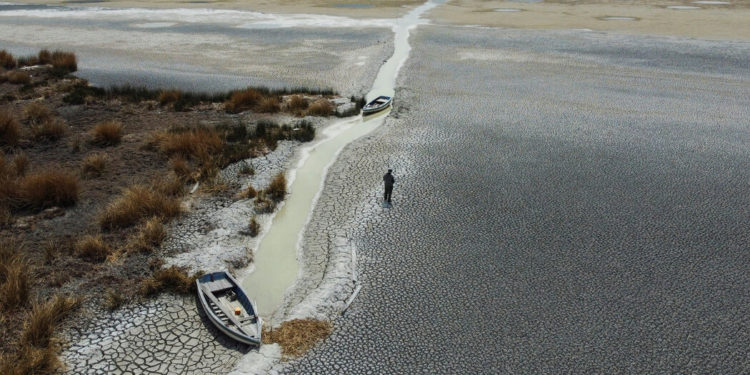By THE NEW YORK TIMES
Pandemic. War. Now drought.
Olive groves have shriveled in Tunisia. The Brazilian Amazon faces its driest season in a century. Wheat fields have been decimated in Syria and Iraq, pushing millions more into hunger after years of conflict. The Panama Canal, a vital trade artery, doesn’t have enough water, which means fewer ships can pass through. And the fear of drought has prompted India, the world’s biggest rice exporter, to restrict the export of most rice varieties.
The United Nations estimates that 1.84 billion people worldwide, or nearly a quarter of humanity, were living under drought in 2022 and 2023, the vast majority in low- and middle-income countries. “Droughts operate in silence, often going unnoticed and failing to provoke an immediate public and political response,” wrote Ibrahim Thiaw, head of the United Nations agency that issued the estimates late last year, in his foreword to the report.
The many droughts around the world come at a time of record-high global temperatures and rising food-price inflation, as the Russian invasion of Ukraine, involving two countries that are major producers of wheat, has thrown global food supply chains into turmoil, punishing the world’s poorest people.
In 2023, the price of rice, staple grain for the global majority, was at its highest level since the global financial crisis of 2008, according to the United Nations’ Food and Agriculture Organization.
Some of the current abnormally dry, hot conditions are made worse by the burning of fossil fuels that cause climate change. In Syria and Iraq, for instance, the three-year-long drought would have been highly unlikely without the pressures of climate change, scientists concluded recently. The arrival last year of El Niño, a natural, cyclical weather phenomenon characterized by warmer-than-normal temperatures in parts of the Pacific Ocean, has also very likely contributed.
Memories of the last El Niño, between 2014 and 2016, are fresh. That time, Southeast Asia witnessed a sharp decline in rice yields, pushing millions of people into food insecurity.
What’s different this time is record levels of hunger, on the heels of an economic crisis stemming from the coronavirus pandemic, compounded by wars in Ukraine and Gaza. A record 258 million people face what the United Nations calls “acute hunger,” with some on the brink of starvation.
The Famine Early Warning Systems Network, a research group funded by the United States government, estimates that the ongoing El Niño will affect crop yields on at least a quarter of the world’s agricultural land.
If the past is any guide, said researchers from FewsNet, a research agency funded by the U.S. govenment, El Niño combined with global climate change could dampen rice yields in Southeast Asia, a region where rice is central to every meal.
Rice is acutely vulnerable to the weather, and governments are, in turn, acutely vulnerable to fluctuations in rice prices. This helps to explain why Indonesia, facing elections this year, moved to shore up rice imports recently. It also explains why India, also facing elections this year, imposed a range of export duties, minimum prices and outright export bans on its rice.
India’s rice export ban is a precautionary measure. The government has long kept large stocks in reserve and offered rice to its poor at deep discounts. The export restrictions further help keep prices low and, in a country where hundreds of millions of voters subsist on rice, they dampen political risks for incumbent lawmakers.
But India is the world’s largest rice exporter, and its restrictions are being felt elsewhere. Rice prices have soared in countries that have come to depend on Indian rice, like Senegal and Nigeria.
Earlier El Niños have also been bad news for maize, or corn, in two regions that rely on it: Southern Africa and Central America. That’s bad for small farmers in those regions, many of whom already live hand-to-mouth and are struggling with already high food prices.
Droughts in Central America affect more than food. In a region where violence and economic insecurity drive millions of people to try to migrate north to the United States, one recent study found that drought can press a heavy finger on the scale. Unusually dry years were associated with greater levels of migration from Central America to the United States, that study found.
Along the Panama Canal, dry conditions forced the shipping giant, Moller-Maersk, to say on Thursday that it would bypass the canal entirely and use trains instead. Farther south, a drought in the Brazilian Amazon has made drinking water scarce and stalled critical river traffic because of extremely low water levels.
Brazil’s drought poses more far-reaching dangers, too. A healthy Amazon rainforest is a huge storehouse of carbon, but not if heat and drought kill trees and fuel wildfires. “If that goes into atmosphere as greenhouse gases, that can be the straw that breaks the camel’s back for the global climate,” said Philip Fearnside, a biologist at the Institute for Amazonian Research in Manaus, Brazil. “Not just the Amazon.”







Discussion about this post